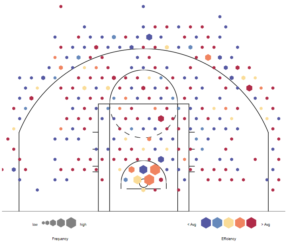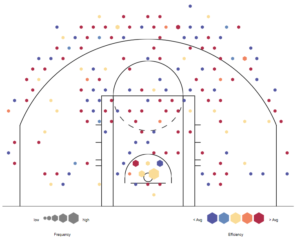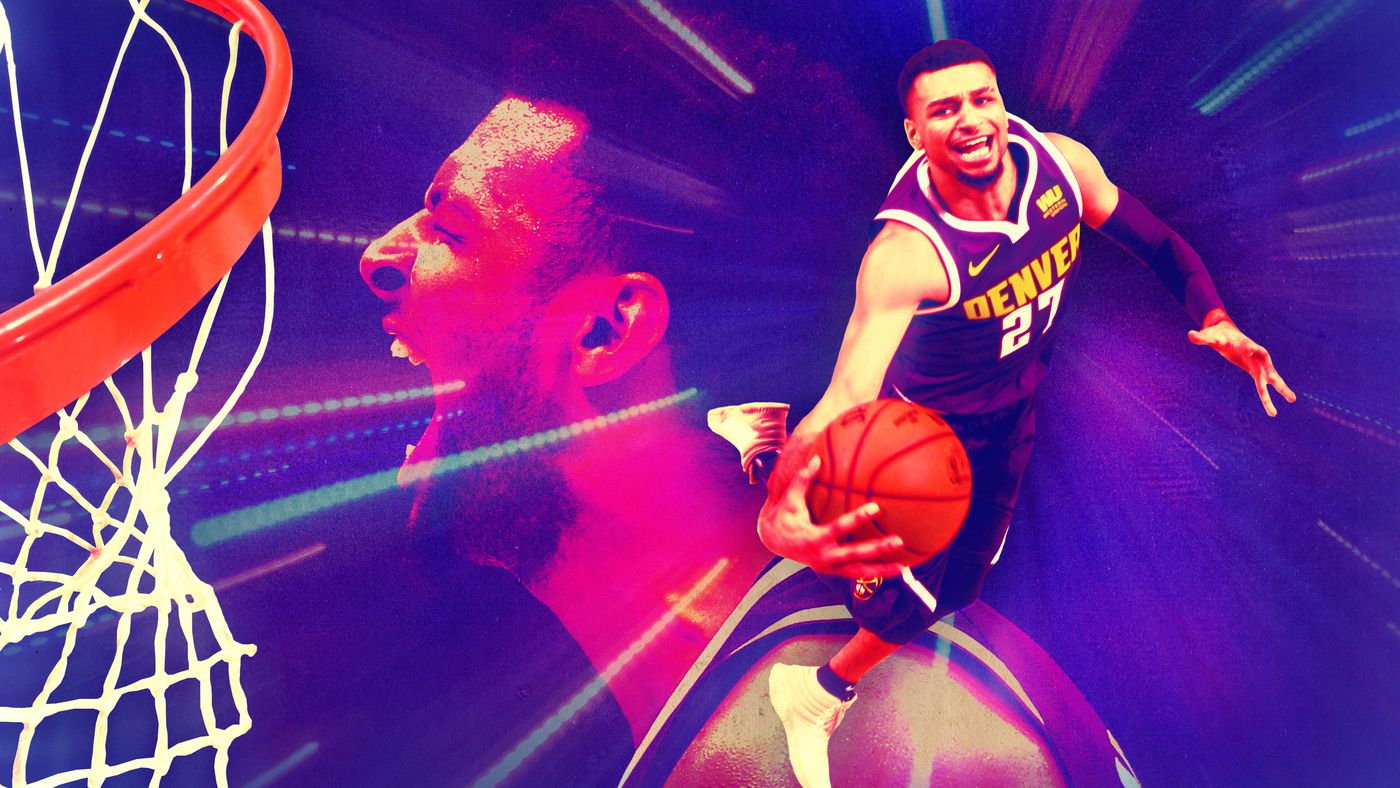(? The Ringer)
Jamal Murray was already showing strong signs of improvement coming into the bubble. He’d taken on an increased load, with notable increments in usage rate and offensive load. More importantly, Murray had started doing more in his time on the court. However, the Playoffs painted a new, renowned picture of Murray’s potential. He exploded in the postseason, with drastic improvements in scoring volume, efficiency, creation, and offensive rebounding. Murray’s stellar performance in the second season left questions as to whether the stint was merely a fluke or an indicator of seasons to come. I’ll attempt to provide an answer to the questions surrounding Murray’s game and determine the overarching principle of my player valuations: what are the percent odds Jamal Murray provides a random team to win a title?
Scoring
Murray’s scoring is largely built around his role as an on-ball driver. For the first time in his career, his usage rate exceeded 25% and his offensive load has exceeded 40%. Murray functions well up top as Denver’s primary pick-and-roll ball-handler, a tandem he enacts with teammate Nikola Jokić as one of the most effective routines in the team’s offense. Murray will use these opportunities to search for shot opportunities at the perimeter or in the mid-range. His highly-effective step-back move is one of the driving points of his superb mid-range scoring; Murray converted on 46% of his 7.4 attempts per 75 from that range. In the Playoffs, he continued this strength and used it to punish the Lakers’ strong defense. Murray improved from every single one of Basketball-Reference‘s primary shooting ranges from the previous season, an indicator of his growing efficiency.
Interestingly, Murray has had an up-and-down track record with scoring efficiency. His True Shooting percentage has been below league-average in three of his four seasons, with the exception in his sophomore year: a product of improved efficiency from two and three-point ranges. In 2020, that mark was a -1.1 rTS%. Murray was the most efficient from inside the arc as he’d been in his career, but subpar distance shooting (34.6% from 3) saw a dip in overall efficiency. However, Murray’s efficiency took an unprecedented leap in the Playoffs, coming in at +6.7% greater than league-average, despite facing three tough defenses in the Clippers, Jazz, and Lakers. If we examine Murray’s shot charts from the regular and postseasons, there are identifiable trends.
Regular Season

Playoffs

Provided by PBPStats, we can see the diversity of Murray’s shot locations decreased from the regular season to the postseason. It can either be attributed to 1) fewer opportunities to expand his locations or 2) a higher dependency on the two most efficient ranges: the perimeter and the paint. There’s a clear decrease in mid-range frequency, especially near the corners. Murray’s mid-range proficiency allowed for less hesitance closer to the free-throw line, but his heavier reliance from three (where he shot 45%) and the rim (where he shot 66%) created drastic changes in his efficiency and volume. For reference, Murray had a ScoreVal (an estimate of points per 100 from scoring) below zero. In the Playoffs, that figure nearly reached 1.5 points, the tenth-highest score in the second season. Murray’s regular-season volume and postseason scoring will likely propel him to All-Star status, but his regular-season efficiency will play a large role in the future of his career. My recommendation: prioritize the ranges he excelled in during the Playoffs, the paint and the perimeter, and cut down on mid-rangers near the corners.
Playmaking
Murray is also one of the league’s better passers and playmakers. During the regular season, he showed promising results on that end with solid transition play and the ability to open up the corners: two prominent spurs of Denver’s offense. The only true knock against Murray’s regular-season passing was a slight lack of recognition in certain plays. There were spots in which he was positioned to split the defense with a bounce pass to a roller, yet Murray would refrain. All things considered, he was a very good playmaker in the regular season, creating around eight shots for teammates every 100 possessions with a Passer Rating eclipsing the six-mark. Murray’s postseason playmaking, however, reached an elite level. Although his Passer Rating was identical to his regular-season mark, the figure doesn’t do justice to how good Murray’s passing was in the second season. This more engaged version of Murray was a near-elite playmaker, creating upward of twelve extra shots every 100 and converting on extremely difficult attempts.
His regular-season playmaking was summed up in his PlayVal, an estimate of points added per 100 from playmaking, which came it over half a point. Already a good mark for Murray, similar to his scoring, his postseason playmaking became elite. Instead, he was contributing nearly 1.5 points every 100, which, similar to his Playoff ScoreVal, was one of the best scores in the entire league. Here, an old question arises: was this postseason jump a fluke? I’d hesitate to say it was; Murray’s passing was certainly better, but it seemed more a product of engagement rather than a lucky burst. His creation doesn’t receive the exact same treatment; some of his proficiency was aided by strong scoring, which is more likely a product of luck. However, it isn’t unreasonable to state Murray is a good, or even very good, playmaker in 2020.
Off-Ball
Similar to the league’s group of on-ball guards, Murray doesn’t provide a whole lot of value without the ball in his hands. This isn’t to say he goes so far as to idle on the perimeter like James Harden. Rather, Murray anticipates regaining the ball in these spots. He’ll often run the ball down the court, after which he’ll snap a quick pass to a teammate on the perimeter and come down near a corner. If Murray doesn’t try any screening action to open a teammate up near the top of the perimeter, he’ll often run a back-and-forth route back up top to get the rock. Murray targets potential screeners on the perimeter for handoffs and a quick path to attack the basket. He’ll rarely find himself camping out in the post, but an elbow isn’t uncommon. These deeper plantings allow for teammates to screen against Murray’s defender, open up Murray, and get him back up top to run some more offensive action. Denver has a great system built around Murray’s lack of elite off-ball value, allowing him to emphasize his strengths and contribute the most he can to the scoreboard when the ball isn’t in his hands.
Defense
Murray is a 6’4″ guard with a 6’6″ wingspan, so without the face value physical traits, his defense would come across as underwhelming. However, the value he brings on the defensive end doesn’t seem to hurt Denver’s defense at all; in fact, it may even help slightly. Murray’s defense has minorly fluctuated over the length of the season, but the aggregate of all his efforts paints a good picture of his defensive capabilities. For example, he shows good hands and hand placement, often finding smart steals opportunities in slowed fastbreak plays. Murray stole the ball 1.3 times every 75 possessions in the regular season. He also has surprisingly strong positioning. Against strong centers like Joel Embiid, Murray was able to keep his matchups in front with planted feet and an upright stance. He’s also a good switch defender, making more automatic rotations than a typical guard. Murray recognizes the need for perimeter coverage as well, and doesn’t fall under the typical umbrella of guards leaving at least one perimeter threat open. I’d argue Murray is a neutral-impact defender in 2020.
Summary
Impact metrics are fairly indicative of Murray’s true value. His offense is typically valued at around two net points per 100 in the regular season, and even higher in the Playoffs. I wouldn’t argue with these scores too much, although Murray’s role as an on-ball talent leads me to believe he wouldn’t experience lesser diminishing returns alongside greater teammates. His defensive scores are also relatively stable. It’s mostly evaluated as neutral in impact, with anomalous scores from metrics like RPM (+1.31 DRPM). It’s worth noting RPM grants Murray a score of -0.39 on offense, without a doubt a large question mark. However, his impact is appropriately represented through impact metrics. I’d estimate Jamal Murray provides a random team with 6.86% odds to win a title at full health.

Leave a Reply